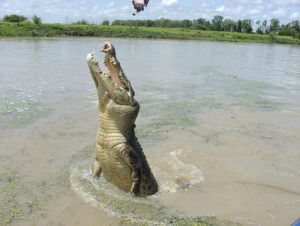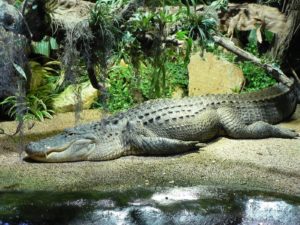By: Barbara Erickson
Crocks are Native to the Americas
Crocodiles first appeared in the fossil record in the Paleocene 65 million years ago. The American Crocodile, Crocodylus acutus, appeared in Latin American fossil records from the Plio-Pleistocene era, some 2 million years ago. Native it is! The crocs among us today qualify as living dinosaurs.

You Can See Them in Ixtapa-Zihuatanejo, Guerrero
One place to see these pre-historic carnivorous reptiles up close, yet safely, is at Playa Linda in Ixtapa Zihuatanejo, Guerrero. There is a bridge near Playa Linda where you can walk out on a viewing platform.
This species is one of the largest of the world’s crocodiles and is considered in danger of extinction due to human prediction and loss of habitat. When you see the numbers of crocs in Ixtapa, you may find this hard to believe. There are no reliable census studies of crocodiles in Mexico, and Ixtapa authorities only recently discovered that tourists enjoy getting a look at these amazing creatures.
Crocodiles are easily distinguished from their more aggressive cousins the alligators by their grayish green color, their narrow tapered triangular snout, and when their mouths are closed, their exposed fourth tooth. They prefer coastal, brackish, and salt-water habitats while alligators prefer fresh water. They tend to flee rather than fight when confronted by their only predator – man.
American Crocs are opportunistic hunters. They remain completely motionless, low in the water and when prey is close they attack – grabbing the animal and drowning it with a maneuver referred to as the “death roll.” This feeding mechanism for large prey is unique in the animal kingdom. For small prey, such as fish or birds, they simply swallow the prey whole.
Once the crocodile has drowned its large prey, it will hold on to one body part and roll its body until the affected part is completely twisted off, thereby creating a bite-size chunk that is easily ingested. If the prey is too large to be consumed in one sitting, it is not uncommon for the crocodile to take it to a hiding place, usually underneath an overhanging bank or submerged log, and consume it later. In order to attract fish for their meal, they may regurgitate bits of food. No wonder it sometimes smells a bit “strong” at the bridge!
Although when you see the crocs, they will be lazing around, they are also able to “high walk” at speeds up to 10 miles an hour! They can swim up to 20 miles an hour for short distances. Large crocodiles can survive for long periods of time between meals due to their very efficient metabolism.
Crocodiles have brains and hearts that are more advanced than any other living reptile. Mother crocodiles care for their young after hatching by providing transportation from the nest to the nearest water source in their mouths and continue to attend to them for up to four weeks after hatching.
American Crocodiles never stop growing and Mexican crocs have measured 15 feet in length, with 20 footers recorded in Central America. They live up to seventy years in the wild.
Crocs are Farmed in Mexico for Meat and Hides
Today crocodiles are farmed in Mexico for their meat and hides. The meat has no fat and little actual flavor with a lobster-like texture so it should be a good protein option for many – if people would add it to their diets!
Travel Tip: depending on the season of your visit, the bridge at Playa Linda is a great place to see herons, egrets, and roseate spoonbills. Don’t forget to walk across the road to the other side of the bridge for more birding.












